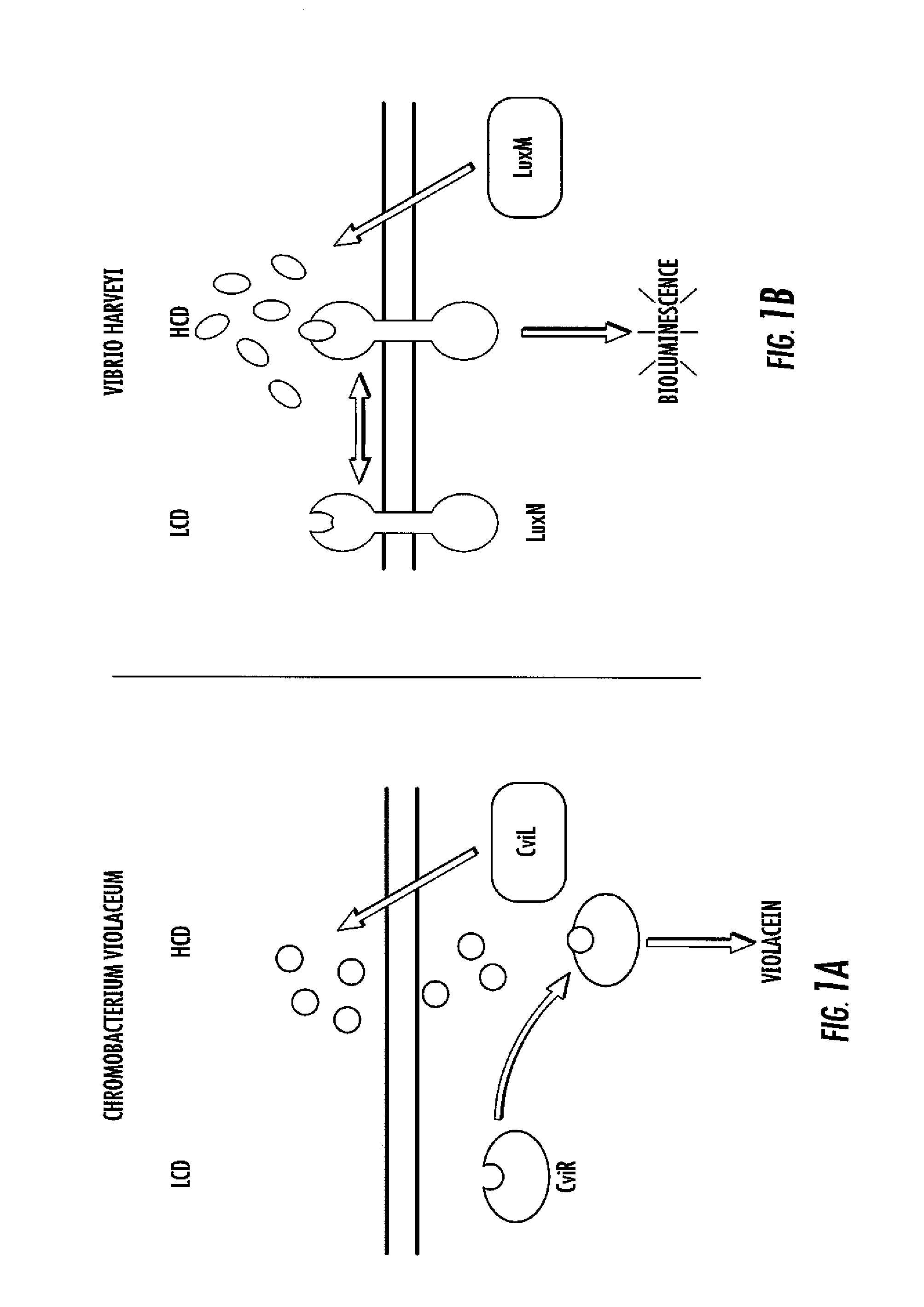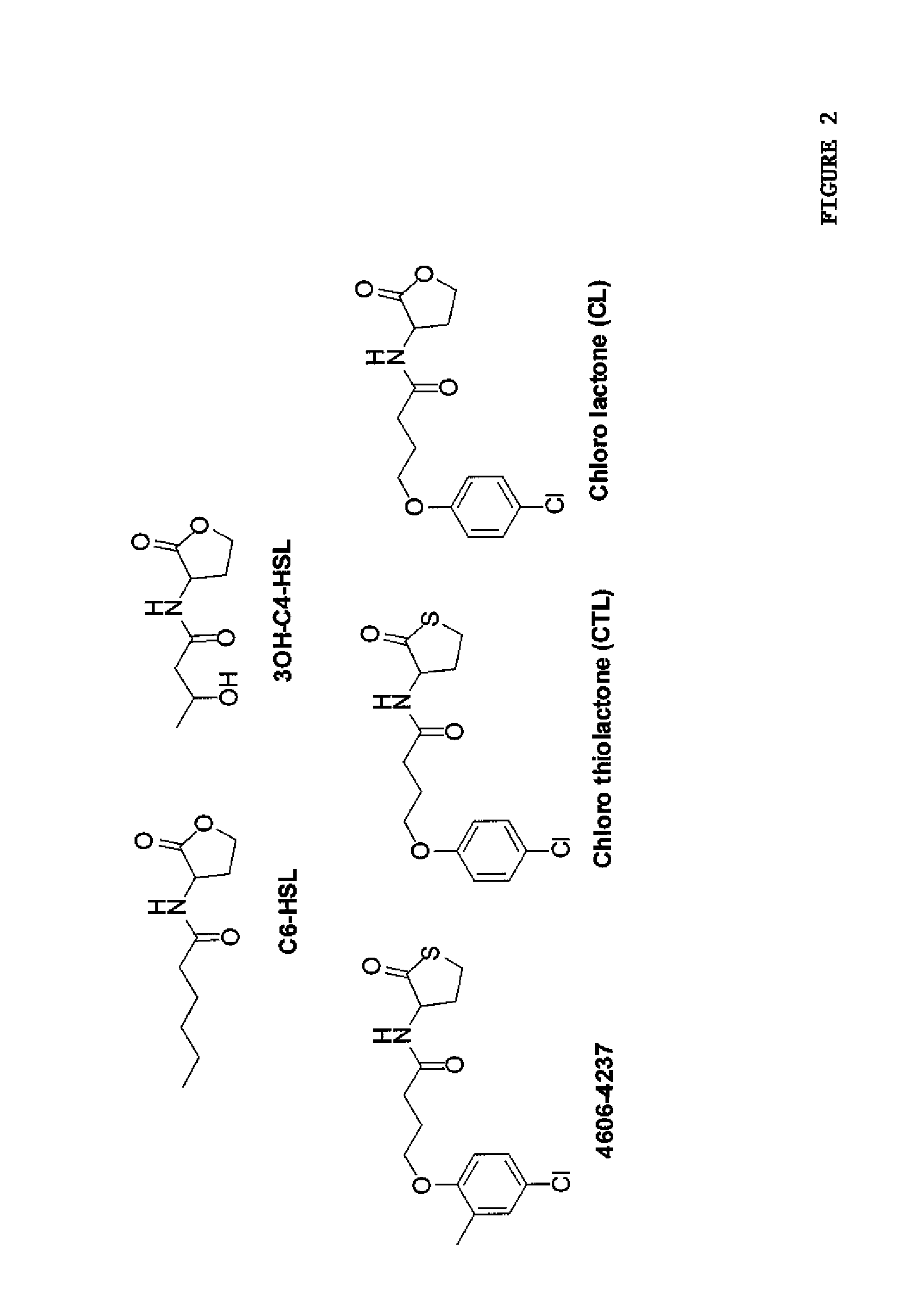Small molecule antagonists of bacterial quorum-sensing receptors
a quorum sensing receptor and small molecule technology, applied in the direction of antibacterial agents, biocide, heterocyclic compound active ingredients, etc., can solve the problems of high difficulty in obtaining a large-scale commercial application, inability to inhibit ahl-mediated quorum sensing in gram-negative bacteria, and inability to provide promising in vivo results
- Summary
- Abstract
- Description
- Claims
- Application Information
AI Technical Summary
Benefits of technology
Problems solved by technology
Method used
Image
Examples
example 1
Analyses of CviR Autoinducer Responses
[0068]To assess LuxR-type AHL sensitivity and selectivity, C. violaceum strain ATCC31532 was employed. C. violaceum synthesizes and responds to C6-HSL (FIG. 2). The quorum-sensing readout for C. violaceum is the easily quantifiable purple pigment, violacein. Violacein production requires CviR binding to C6-HSL at high cell density and subsequent activation of transcription of the vioABCDE biosynthetic gene cluster that is responsible for violacein production. C. violaceum also possesses a repressor of vioABCDE. The repressor locus was identified and characterized (gene CV1055). This repressor is inactivated in the violacein assay strain.
[0069]To examine the specificity and sensitivity of CviR, an E. coli strain was engineered that expresses CviR and contains a plasmid harboring the vioA promoter fused to green fluorescent protein (gfp). Thus, the ability of CviR to activate transcription can be assessed by measuring gfp expression in the presenc...
example 2
Identification of CviR Antagonists
[0071]High-throughput chemical library screens had identified 15 molecules that inhibit AHL detection by the membrane-bound two-component AHL receptor LuxN (structures are provided in FIG. 8A). Experiments were undertaken to establish whether any of these LuxN antagonist molecules could also interfere with AHL binding to CviR. To examine this, each of the 15 molecules was tested for inhibition of in vivo violacein production in C. violaceum. For this set of experiments, a C. violaceum evil mutant that produces no endogenous AHL signal was used. The native C6-HSL signal was added exogenously and held constant at 5 μM and violacein production was measured in the presence of 50 μM of each potential antagonist (FIG. 8B). Importantly, because the cviI mutation in the C. violaceum test strain renders it incapable of AHL production, this strain does not produce violacein in the absence of exogenously supplied AHL (FIG. 8B, bar denoted No HSL). One of the L...
example 3
Characterization of the CviR Antagonist 4606-4237
[0072]To quantify the in vivo potency of 4606-4237, further characterization was undertaken of violacein production in wild type C. violaceum (i.e., the wild type strain carrying a functional evil gene that produces native levels of C6-HSL) in response to 4606-4237 at concentrations ranging from 45 nM to 100 μM (FIG. 3C). The antagonist, 4606-4237 inhibits violacein production in C. violaceum with an IC50 value of 1.2 μM (FIG. 3C). To determine if 4606-4237 inhibits violacein production specifically by interfering with CviR, 4606-4237 was tested for antagonism of CviR in the recombinant E. coli vioA-gfp assay. For these experiments, C6-HSL was held constant at 500 nM, while 4606-4237 was titrated from 1.3 nM to 100 μM (FIG. 3D). This concentration of native C6-HSL signal induces maximal gfp production in this heterologous assay system. Importantly, no C. violaceum components other than CviR are present in the recombinant E. coli assay...
PUM
| Property | Measurement | Unit |
|---|---|---|
| pH | aaaaa | aaaaa |
| concentration | aaaaa | aaaaa |
| cell-population density | aaaaa | aaaaa |
Abstract
Description
Claims
Application Information
 Login to View More
Login to View More - R&D
- Intellectual Property
- Life Sciences
- Materials
- Tech Scout
- Unparalleled Data Quality
- Higher Quality Content
- 60% Fewer Hallucinations
Browse by: Latest US Patents, China's latest patents, Technical Efficacy Thesaurus, Application Domain, Technology Topic, Popular Technical Reports.
© 2025 PatSnap. All rights reserved.Legal|Privacy policy|Modern Slavery Act Transparency Statement|Sitemap|About US| Contact US: help@patsnap.com



